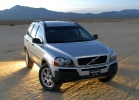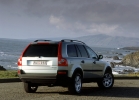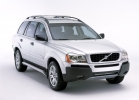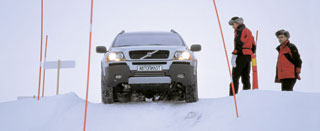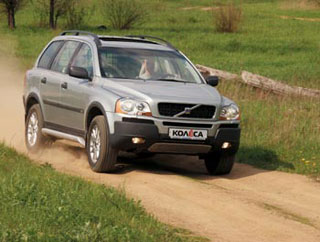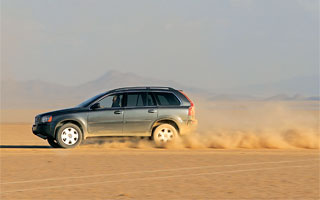Test drive Volvo XC90 2002 - 2006 SUV
Volvo goes off -road
XC90, whose debut took place in January 2002 at the Detroit car dealership, the first real VOLVO SUV. Although it is produced in Sweden, it is intended mainly for the American market. I must say, the car turned out to be very successful. No wonder in 2002 the Americans assigned him the title of the best car in the SUV category.The American market has well accepted the new model. Initially, the Swedes planned to produce 50 thousand such cars a year, but soon increased demand forced to increase production to 90 thousand. Nevertheless, a significant part of potential buyers went to competitors due to the fact that there was no version with 8- in the XC90 lineup for a long time with 8- cylinder engine. Such people are Americans, give them a car with a powerful eight and that's it. And at the end of 2004, the production of the long -awaited XC90 with the V8 engine began, and now it can be ordered in Moscow. As a result, it became possible to compare the early versions of the XC90 with 5 and 6-cylinder engines with similar cars equipped with the V8 engine.
Externally, cars with a new engine are almost no different from their less powerful counterparts. It is possible to identify the XC90 V8 only on a fake grate of graphite color, chrome air intake edging in the bumper and nameplate V8. The salons are the same, and the basic configurations differ slightly, except that the XC90 V8 has added cruise control.
Thus, by and large, the new version of the XC90 differs from its predecessors only by the engine. But how! The V8 motor developed by the Japanese company Yamaha, a real work of engineering. Today it is one of the most compact and light 8-cylinder power units in the world. It weighs 190 kg, which is only 15 kg larger than the in -line Six Volvo, and in the engine compartment it is placed transversely, as well as other engines installed on the XC90. Thanks to the compactness and ease of the new V8, Volvo designers did not have to change the machine layout and reconfigure the suspension parameters. Outwardly, Yamaha engine, completely made of aluminum alloys, is so beautiful that Volvo designers did not hide it under a traditional plastic lid. They say that soon the motor compartments of all Volvo models will look like that. The characteristics of the new V8 are also worthy of respect. The engine produces 315 liters. With. At 5850 rpm and develops the maximum torque of 440 nm at 3900 rpm. So that such a motor can fully realize its capabilities, the latest 6-speed automatic transmission is installed on the XC90. The fundamental scheme of all -wheel drive remained unchanged. Volvo engineers are still using Haldex coupling, but its design is significantly modernized. Now, at a speed of up to 15 km/h XC90, it has a drive to all wheels, with further dispersal, the car actually becomes front -wheel drive, on the front wheels it accounts for 95 % of the transmitted torque. In case of slipping, the electronics instantly increases the traction force on the rear wheels. Also, the new Haldex transmission version is designed to transmit more torque. Although the average fuel consumption per 100 km XC90 with an 8-cylinder engine increased slightly (approximately 1.52 liters more than that of the 5-cylinder version and by 0.50.7 liters compared with the 6-cylinder), the fuel tank capacity increased From 72 to 80 liters, thanks to this, the stroke has grown. Like the rest of the Volvo engines, the new V8 is able to work on gasoline with an octane number 9198.
Before testing the updated car on the go, we will ride on the XC90 with 5- and 6-cylinder engines.
So, we get in a car with a turbocharged five. The engine itself is not bad. Its power (210 hp) is enough for a dynamic driving. Up to 100 km/h the car accelerates in 9.9 s. However, in order to maintain a high pace of movement, you often have to switch transmissions, forcing the engine to work at increased speeds. At the same time, the cabin is noisy, and the fuel consumption increases. As an option, an option is offered with a 5-speed automatic transmission, but the behavior of the car almost does not change. On off -road, a car with such an engine behaves quite decently. A good characteristic of the torque (320 nm in the interval is positively affected here from 1,500 to 1800 rpm).
The XC90, equipped with an in-line 6-cylinder turbo engine (2.9 liters, 272 hp), has approximately the same character. It is currently the most compact in -line six in the world. To place such an engine transversely in the XC90 engine compartment, Volvo engineers had to solve many technical problems: 6-cylinder cars are equipped with only 4-speed automatic transmissions, since a more modern 5-speed machine simply did not fit in a close motor compartment. In general, the XC90 behavior with six is \u200b\u200bnot very different from the version equipped with a 5-cylinder engine. A little better the acceleration time to 100 km/h (9.3 s), a more successful characteristic of the torque (380 nm at 18005000 rpm).
Well, now we test the XC90 V8. I must say that the character of a machine with a 8-cylinder engine has changed significantly. Due to a significant increase in power, as well as the fact that at low speeds the machine has a drive to all wheels, it has become noticeably better: 100 km/h XC90 V8 is gaining only 7.3 s.
The new motor allows you to fully disclose the potential of the car. If you do not go fast, the difference with less powerful versions is not so significant, but if you press the accelerator pedal to the floor, excess horsepower under the hood makes themselves felt. The dynamics of the XC90 V8 acceleration is impressive. The work of a new 6-speed gearbox is worthy of praise and work. The delays in switching during intensive acceleration are minimal, at the same time the transition from one step to another occurs smoothly, without jerking. Management and off -road characteristics have not changed much, since the suspension design did not touch. The maximum speed of all versions of the XC90 is limited by electronics at a mark of 190 or 210 km/h, depending on the size of the wheels.
Today, the most affordable XC90 with a 5-cylinder engine costs $ 61,900. Prices for the basic version with six start at $ 72,900, and $ 87,900 are already asking for the XC90 V8.
Is it worth overpaying for a powerful engine? Decide for yourself. On the one hand, 5-cylinder is quite enough for daily use. On the other hand, it is much more interesting to drive a car with an eight under the hood.
What does the XC90 V8 look compared to competitors?
The car under consideration belongs to the category of the so -called crossovers of cars intended primarily for operation on good roads, but at the same time having good cross -country ability. The ancestor of this class was the BMW X5, which is still a standard. In addition to BMW there is Volkswagen Touareg, perhaps that’s all. Other European manufacturers have not yet released a car of a similar class with the V8 engine. I must say, the competitors of Volvo are few, but very strong. In separate sledgal disciplines, XC90 is slightly inferior to them. True, this difference is not so significant in real operation. In addition, the XC90 has their trump cards. Firstly, the Volvo SUV is approximately 1020 % cheaper than the BMW X5 in a similar configuration. Secondly, due to the transverse location of the XC90 engine, it has a more compact motor compartment. As a result of this, with approximately the same external dimensions, Volvo’s interior is spacious. XC90 is released in 5- and 7-seater options. Unlike competitors in Volvo, even on the last, third, a number of seats are quite spacious. At the same time, the salon is not only larger than that of classmates, but more convenient. Volvo developers paid considerable attention to ergonomics. Thirdly, the XC90 has no equal in the security area of \u200b\u200bboth active and passive. In fact, today Volvo is the only company in the world seriously engaged in the safety of SUVs. The fact is that crash tests conducted according to traditional methods, as a rule, do not give a real picture of damage to the car as a result of an accident. In the case of SUVs, the differences between experiments and real accidents are especially noticeable. The center of gravity of machines of this type is located higher than that of cars, so the likelihood of overturning the SUV is several times more. Given this, Volvo, along with the use of traditional security tools, applied a unique complex of electronic stabilization devices to reduce overturning on the XC90. In addition, the XC90 has a very hard body, so if the accident happens, passengers are unlikely to be seriously injured.
And another serious argument in favor of the purchase of the XC90. It so happened that almost all the cars of prestigious brands in our country have a reputation for gangsters. Apparently, nothing can be done here. Volvo in some incomprehensible way managed to maintain a reputation as a company producing cars for intellectuals. If you are not indifferent to the attitude of others to yourself, this fact should be taken into account. It is also important that Volvo products are of little interest to representatives of the criminal world, so the probability of theft is very low. True, the case is not only in the company's image, but also that the XC90 install a very serious anti -theft complex that includes an immobilizer, alarm with remote control and autonomous power, and the so -called dead locks on all doors and hoods.
Video Crash tests Volvo XC90 2002 - 2006
Test drives Volvo XC90 2002 - 2006
Krash -test Volvo XC90 2002 - 2006
Krassh Test: Detailed Information34%
Driver and passengers
10%
Pedestrians


